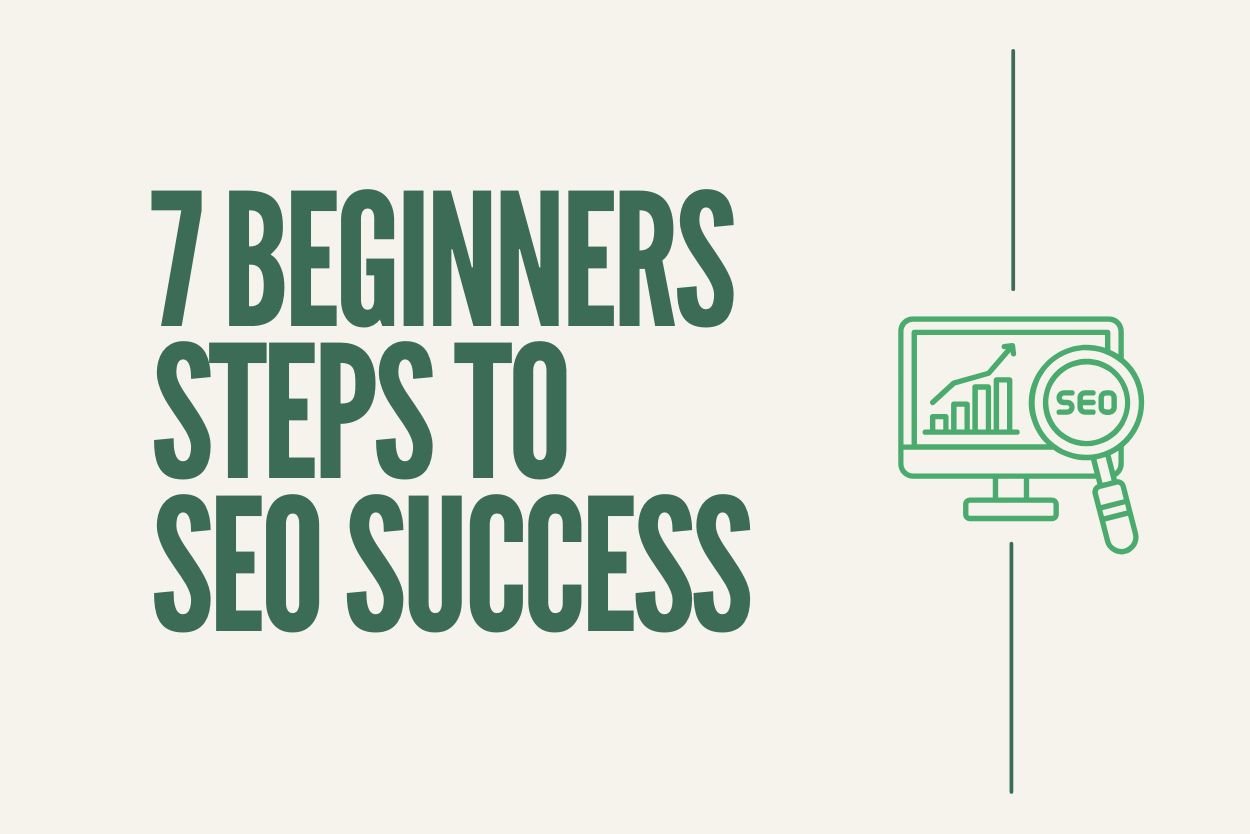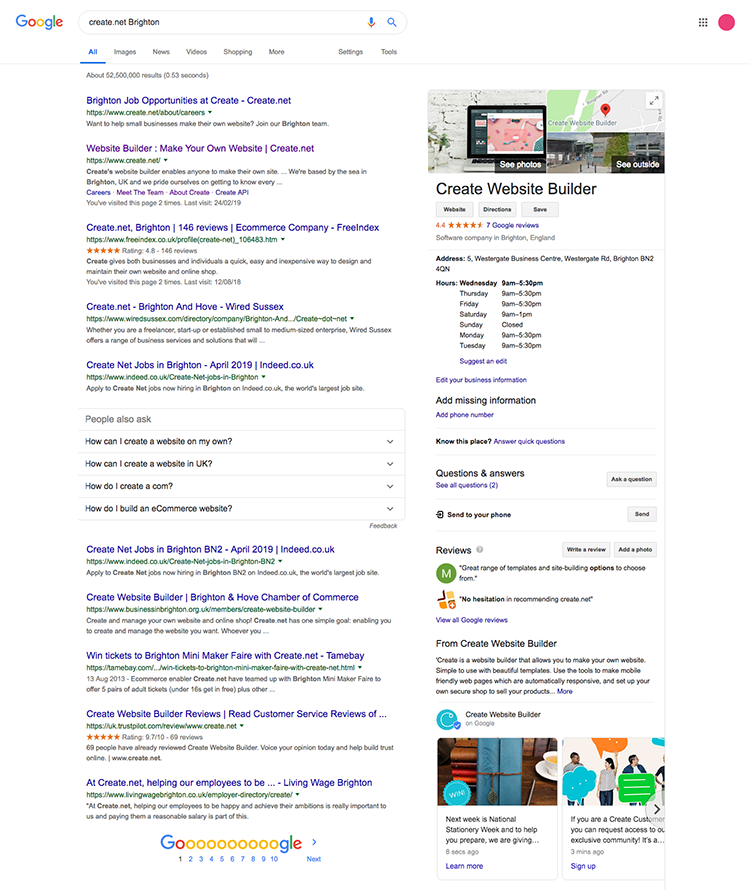Blog > SEO for Beginners: 7 Simple Actions to Boost Your Website

If you want to get your website listed in the search results of Google and Bing then this blog post is for you. You may be worried it’ll be too technical but if you follow the actions we’ve set out below then you’ll have laid the foundations for a well optimised website.
With Google handling 8.5 billion search queries every day, it’s worth taking a bit of time to get your website set up for success and make it possible for your potential customers to start finding your website when they search.
Let’s dive into seven essential actions that will get your website ranking in the search results.
1. Setup Google Search Console and Bing Webmaster Tools
It’s often assumed that Google and Bing will just find websites by themselves. Very occasionally this can happen, but we don’t recommend that you sit back and leave it to chance.
It’s straightforward to inform Google and Bing about your website as they both provide tools for you to do so. Google provides Search Console, and Bing has its Webmaster Tools. We recommend setting up both but, if you’re going to choose, Google is the most important.
To get started you’ll need to make accounts with both of these tools and we have provided clear steps on how to setup and verify your website, just follow the instructions in our guides below:
How To Setup Google Search Console
How To Setup Bing Webmaster Tools
Once setup these tools let you monitor your website’s presence in the search results. You can submit your sitemap (more on that below), check for issues, view websites that are linking to you, and you’ll be able to see which keywords are bringing visitors to your site. All this exciting information will be yours as soon as you have your website in the search engine indexes!

Pro Tip: Setup Google Search Console first. Bing can then use the same verification with their handy import feature to save you time and effort. |
2. Tell Google and Bing About Your Website

Now you’ve got your accounts set up, the next step is to submit your website. To do this you’ll need a sitemap file. This is a file that lists all the pages on your website. It helps search engines understand your site’s structure and index it more effectively.
We automatically make your sitemap files, so you don’t need to worry about that step, plus every time you publish your website we’ll automatically make any changes, so they’re always up-to-date.
In your new search engine accounts there’s a place for you to submit the details of your sitemap to them.
Just follow the steps in these guides:
How To Submit Your Sitemap In Google Search Console
How To Submit Your Sitemap In Bing Webmaster Tools
Want Your Own Website?
Start Building Today!
No credit card needed. By submitting this form you agree to our T&Cs and Privacy Policy.
3. Identify Your Keywords
Your keywords are the words and phrases that your customers are typing in to find your products and services. You should include these keywords through your website and ideally have one target phrase for each page of your website.
If you don’t know what keywords your customers are typing in to find products and services like yours then you’ll want to do some keyword research. It’s also important when doing the research that you look at how often the terms you think customers will type in are searched. If you’re optimising your website for words that aren’t searched it’s not going to result in a lot of visitors coming to your website.
How often words are searched is known as search volume and you’ll want to balance the volume with how relevant the terms are for your business. Choose keywords that tick both boxes in a reasonable way.
It’s also good to keep in mind that there can only be one person or business in the number one spot and high volume search terms will be very, very competitive. Therefore it’s best to begin your optimisation by targeting longer phrases or even questions your customer might ask to find your services. Keep in mind whether your customer will be using local search terms to find you too.
There’s a number of tools available to help you determine which keywords to optimise your website for and our guide on Keyword Research details a number of options you can try out.
When you’re deciding upon your keywords, review each page of your website to determine what the content talks about. You should aim for each page of your website to target a different keyword phrase. Go through and match your chosen keyword terms to the most relevant pages.
Read more about how to do Keyword research here

Pro Tip: Your home page will always have the best chance of ranking highly, so choose the keyword phrase you think is most important for your website and work your home page content around this. |
4. Optimise Your Website’s Metadata
Having decided on the keywords to target it’s time to add these into your Page Title and Page Description metadata (also known as Meta Tags). This Metadata information is sometimes used by the search engines when they display your website in their results.
Therefore optimising your Metadata helps the search engines to understand your content and is your opportunity to encourage users to click on your link in the search results.
To add your Title and Description tags to your website pages login to your Create account and follow our guide. You should include your keyword phrase in your title and in your description.

How To Write An Optimised Page Title
* Include your keyword phrase in a naturally written way.
* Keep your page title between 45 and 65 characters. To help you check the length of your Page Title, you can use our meta length checker tool here.
* Ensure it’s an honest summary of what the visitor will find on your page. If you trick visitors to arrive and they leave quickly (known as bouncing), Google will assume your page is not relevant to the search result and demote your position.
* If you’re including your company name or brand, add it at the end.
How To Write A Good Meta Description
* Keep your description around 155 characters, if you use too many characters your description is likely to be truncated.
* Don’t be afraid to use emotive language, your meta description is a sales pitch and should be designed to get attention.
* Include a call-to-action (if relevant) at the end of the description to encourage people to click through.
* Ensure the description is unique and not repeated on any other pages of your website.
* Avoid stuffing too many repetitive keywords, stick to the main one and ensure the rest is natural language that supports this.
Example: If you have a blog post about healthy smoothie recipes, a good title might be: “5 Easy and Healthy Smoothie Recipes to Start Your Day” and a description like: “Discover simple, nutritious smoothie recipes perfect for breakfast. Start your day right with these easy-to-make drinks.”
Read more about Meta Tags here
5. Add Alt Descriptions
To Your Images Alt Tags (alternative text) are descriptions which you can add to the images on your website. The purpose of the Alt Tag is to provide a textual description of an image, primarily this is to make content accessible to people with visual impairments and screen reading tools.
It’s best practice to provide accessible information on your website and also an opportunity to add some additional descriptive content and relevant keywords to your website as Search Engines use this information to understand what an image is.
If you haven’t been adding these, don’t panic, just work through each page of your website as and when you can. Prioritise the home page and then the pages in order of importance.
Follow our guide for step by step instructions on how to add Alt Tags to your website images.
How To Write Good Alt Tags
* Whilst there’s no official limit to how long an Alt Tag can be remember that it’s primary use is for screen readers. A very long Alt Tag can disrupt the visitors flow as they visit your website. Aim to stick to less than 100 characters.
* Write a clear, concise description of the image. For example Two happy dogs visiting the park for their daily walk.
* Include your keywords naturally, avoid keyword stuffing.
* Keep it relevant to the picture. As the use of AI increases and the search engines better understand what images are of, Alt Tags which don’t reflect the images shown could be seen as attempts to manipulate your search position.
Don’t forget to publish your changes to your live site as you go.
6. Google My Business Listing
If you have a business with a physical office or store then having a Google My Business is worth taking the time to set up. Google My Business gives you an additional business listing and enables you to provide extra information to Google that will be displayed when people search for you.
One of the biggest benefits is that your business can receive more screen space and prominence in the search results - particularly when people are using local searches.
If you’re running a cafe, attraction or business open to the public this will also give you a position on Google’s map services, another great way for your business to be discovered.
To get started head to Google, sign in with your Google account and Claim Your Business Profile. If your business isn’t already listed then you can create a new profile.

How To Optimise Your Google My Business Listing
* Provide complete information including essential details like your business name and address, how people can contact you, your website and hours of operation.
* Add a description of what you do and include some of your main keywords, keep it natural, helpful and enticing. Like your Meta Descriptions above you want people seeing it to click through to your website, or visit your premises.
* Upload high quality images of your store front, premises, products, services and experiences to make your profile visually appealing. This is also helpful to people who may be deciding to visit you.
* Add links to events, new products, articles and other relevant content from your website. You can publish new articles here, in the same way as you would share them on social media. Don’t forget to update this section regularly too. Optimising your Google My Business profile can make a big difference in how potential customers discover and interact with your business online.
Read more on how to setup Google My Business
7. Add New Content Regularly
Search engines love fresh, valuable content. By creating blog posts, adding new products, case studies and testimonials, or just generally updating your website, Google and Bing will see that your website is active and current.
It is also the case that the more great pages of content you create that are tailored to specific keywords, the more chances you have of showing up in relevant search results to your audience.
Creating useful articles is an easy way to do this regularly, use your blog and write for your audience around a question you are often asked. Talk through the ways you provide the solution and encourage them to purchase your products, or get in touch to discuss how you can help them.
If you’re stuck for ideas on what to write, check out our handy article featuring 25 creative Ideas to help you write your first blog post.

Wrapping Up
Starting your website’s SEO may seem like a lot to tackle, but taking it step by step as we’ve outlined above will make it much more manageable. With these seven actions you’ll be building a solid foundation for long-term success.
Plus our blog and support areas have a wealth of information and best practice for further improving your website and search ranking, check them out if you’d like more tips and advice.
Our Facebook Community Group is also a great place to find more information and to ask questions.
And finally, it’s good to remember that SEO isn’t a sprint, it’s a marathon. Please don’t see it as a one-time task because small, consistent improvements can lead to significant results over time. Get started with the actions above today and take your foundational steps towards the long-term success of your website.
Want Your Own Website?
Start Building Today!
No credit card needed. By submitting this form you agree to our T&Cs and Privacy Policy.



